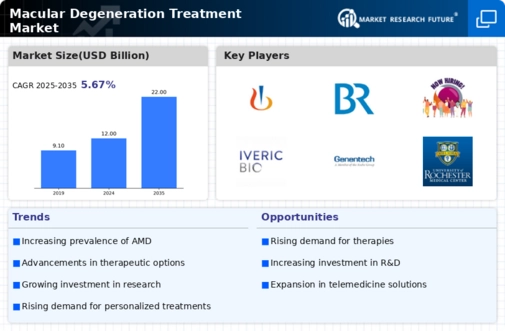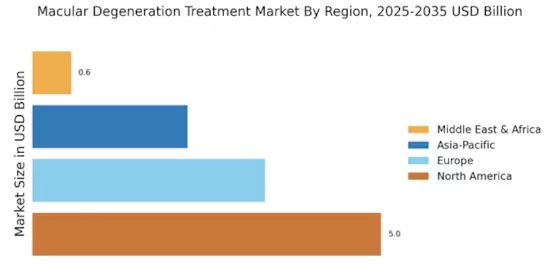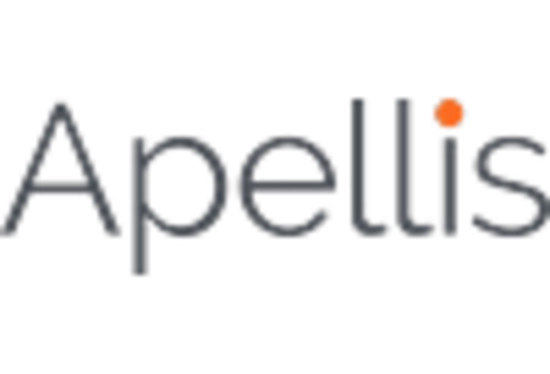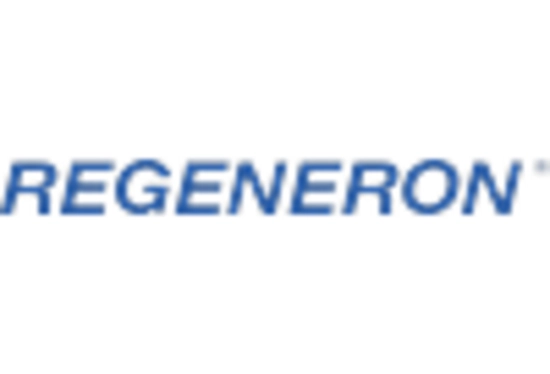Rising Healthcare Expenditure
Rising healthcare expenditure is a significant driver of the Macular Degeneration Treatment Market. As countries invest more in healthcare infrastructure and services, access to advanced treatments for macular degeneration improves. Increased funding for research and development in ophthalmology has led to the discovery of novel therapies and technologies aimed at treating AMD. According to recent data, healthcare spending is expected to grow at an annual rate of 5.4%, which will likely enhance the availability of treatment options for patients. Furthermore, the willingness of patients to invest in their eye health, coupled with insurance coverage for innovative therapies, is expected to drive market growth. This trend indicates a shift towards prioritizing preventive care and early intervention, which is crucial for managing macular degeneration effectively. Consequently, rising healthcare expenditure plays a pivotal role in shaping the Macular Degeneration Treatment Market.
Increased Awareness and Education
Increased awareness and education regarding macular degeneration are vital drivers of the Macular Degeneration Treatment Market. Public health campaigns and initiatives aimed at educating individuals about the risk factors and symptoms of AMD have led to greater recognition of the disease. As awareness grows, more individuals seek early diagnosis and treatment, which is essential for preserving vision. Moreover, healthcare professionals are increasingly emphasizing the importance of regular eye examinations, contributing to early detection and intervention. Market data suggests that regions with robust educational programs experience higher rates of treatment uptake, indicating a direct correlation between awareness and market growth. This trend underscores the necessity for continued efforts in public education and outreach, as they are likely to enhance patient engagement and drive demand for effective treatments in the Macular Degeneration Treatment Market.
Advancements in Treatment Modalities
Recent advancements in treatment modalities are significantly influencing the Macular Degeneration Treatment Market. Innovative therapies, such as anti-VEGF injections, have transformed the management of wet AMD, leading to improved visual outcomes for patients. The introduction of new drug formulations and delivery systems, including sustained-release implants, is expected to enhance treatment adherence and efficacy. Additionally, the development of gene therapies and stem cell treatments holds promise for addressing the underlying causes of macular degeneration, potentially altering the disease's trajectory. Market data indicates that the anti-VEGF segment alone is projected to account for a substantial share of the market, driven by its widespread adoption and proven effectiveness. As these advancements continue to emerge, they are likely to attract investment and research efforts, further propelling the growth of the Macular Degeneration Treatment Market.
Aging Population and Rising Prevalence
The aging population is a primary driver of the Macular Degeneration Treatment Market. As individuals age, the risk of developing age-related macular degeneration (AMD) increases significantly. It is estimated that by 2030, the number of people aged 65 and older will reach approximately 1.5 billion, leading to a corresponding rise in AMD cases. This demographic shift necessitates the development and availability of effective treatments, thereby propelling market growth. Furthermore, the prevalence of AMD is projected to double by 2050, indicating a pressing need for innovative therapies and interventions. The increasing awareness of eye health among older adults also contributes to the demand for treatments, as individuals seek to maintain their quality of life and independence. Thus, the aging population serves as a crucial catalyst for advancements in the Macular Degeneration Treatment Market.
Technological Innovations in Diagnostics
Technological innovations in diagnostics are reshaping the Macular Degeneration Treatment Market. Advanced imaging techniques, such as optical coherence tomography (OCT) and fundus autofluorescence, enable earlier and more accurate detection of macular degeneration. These technologies facilitate timely intervention, which is crucial for improving patient outcomes. The integration of artificial intelligence in diagnostic processes is also emerging, potentially enhancing the precision of assessments and treatment planning. As diagnostic capabilities improve, healthcare providers can offer personalized treatment strategies tailored to individual patient needs. Market data indicates that the demand for advanced diagnostic tools is on the rise, driven by the need for efficient and effective management of AMD. Consequently, these technological advancements are likely to play a significant role in the evolution of the Macular Degeneration Treatment Market.


















Leave a Comment